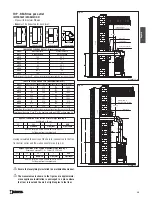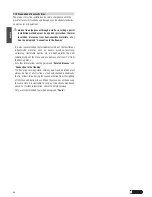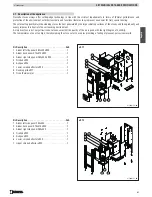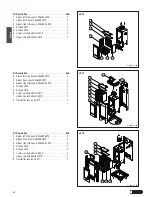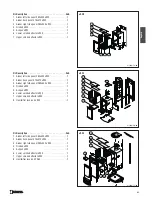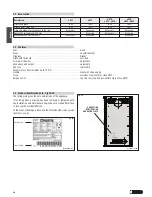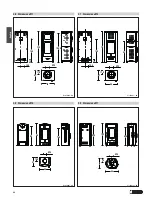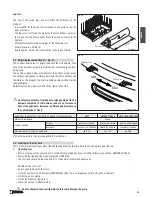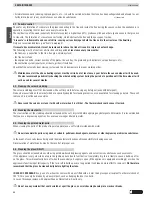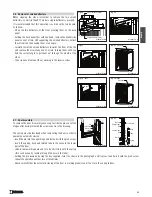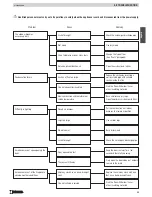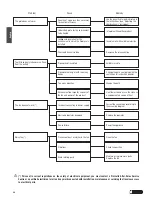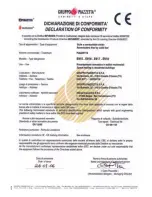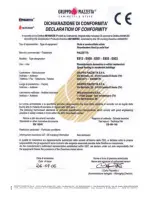
English
51
3.7 Operation under adverse weather conditions
During the intermediate seasons with adverse weather conditions or when outdoor temperatures are higher, a sudden rise can cause
malfunctioning of the draught, thereby impeding proper smoke discharge. In this case the grate must be loaded with only a little wood
and the primary air damper be set fully open so that the wood burns faster and thereby stabilises the draught.
3.8 Overheating and Extinguishing
In the event of overheating or if some appliance parts or the flue turn red:
- immediately stop the supply of fuel;
- do not open the stove door;
- close the air dampers (MINIMUM position);
The fire will go out due to lack of air.
When the appliance has cooled down, find the cause of the problem and if necessary call in specialised personnel.
In the event of fire, extinguish with a fire extinguisher.
Do not extinguish the fire with water.
Air the room well before using it again in order to get rid of any smoke and combustion gases.
3.9 Humidifier (only in stove e917 – e918 – e922 – e923)
It's possible to humidify the room where the stove is installed, using the “500cc sprayer phial” pour water in the tank through the hole
on the cooking surface. Pay careful attention not to fill the reservoir beyond the limit fixed on the reservoir, indicated with the symbol
“MAX”, otherwise water overflows from the humidifier.
3.10 Using the oven (only in stove e911)
A cooking guide is not provided since experience is the best teacher, which, added to personal imagination and skill, will help you to create
excellent dishes. The thermometer provided in the kit will undoubtedly help by showing the right moment for putting in the food, while
the large ceramic glass door allows you to see how cooking is progressing.
On the other hand a few tips will surely be useful:
- bring the product up to temperature starting with small pieces of wood and only gradually adding larger pieces. Never exceed the
recommended load;
- do not put food into the oven as soon as the required temperature has been reached since it is highly probable that the temperature will
continue to rise with the risk of ruining the food in the oven;
- at a certain point the temperature will start to drop. When it remains stable for a few minutes, this is the best time to put food into the oven;
- it is inadvisable to exceed 250°C as this is more than sufficient for every type of cooking. Only in the initial stages may a peak of 280-
300°C be reached.
Higher temperatures are not only unsuitable for correct cooking, but could make the structures expand too much;
- once the food has been put into the oven, just keep the temperature constant by a calibrated stoking up with wood and suitable
adjustment of the air dampers. Only experience will teach you the best conditions for cooking a certain food, the quantity of wood to
burn in a given time and the position of the dampers, remembering that everything also depends on external factors such as the draught
and the weather;
- remember that the thinner the food to be cooked, the less time and more heat are necessary; for example a chicken requires a long cooking
time (approx. 3 hours) at low heat (150-180°C) while a pizza cooks quickly (approx. 10 minutes) at higher temperatures (220-230°C);
- if the flue pipe creates excessive draught or the wood in any case burns fiercely developing excessive heat with difficulty in controlling
combustion, the heat is not correctly transferred to the oven but passes directly into the flue; it is advisable to add fuel as recommended
and adjust the air dampers. Only if strictly necessary should a pipe with damper be installed;
- for cooking at low heat, shut off the primary air, keeping the secondary damper approximately half or a quarter open and keep any smoke
damper partly open to ensure an adequate draught;
- successful cooking also depends on the wood that is used: hard wood (e.g. beech) and large logs burn more slowly and last longer,
while small logs and softer wood develop a more intense but short-lived flame;
- when taking the food out of the oven to check the state of cooking, close the door to avoid the temperature dropping in the oven.
A change in colour of the oven is a natural feature of steel subjected to sudden changes in temperature. This does not affect the
quality of the product.



